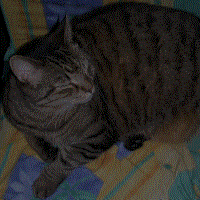Unlike encryption, where it's obvious that a message is being hidden, steganography hides data in plain view, such as inside a picture. To anyone who isn't aware that it contains hidden data, it looks like just a normal picture.
One of the most widely used techniques and perhaps simplest to understand is the least significant bit technique. This technique changes the last few bits in a byte to encode a message, which is especially useful in an image, where the red, green, and blue values of each pixel are represented by eight bits ranging from 0 to 255 in decimal or 00000000 to 11111111 in binary.
Changing the last two bits in a completely red pixel from 11111111 to 11111101
only changes the red value from 255 to 253, which to the naked eye
creates a nearly imperceptible change in color but still allows us to
encode data inside of the picture.
 |
| This diagram shows two 4-pixel images in both color and binary values. Each block of binary represents the value of the corresponding pixel. |
 | |
| Image of a tree with a steganographically hidden image. |
The hidden image is shown below.
 |
| Image of a cat extracted from the tree image above. |
Sources
- Wikipedia Steganography
No comments:
Post a Comment